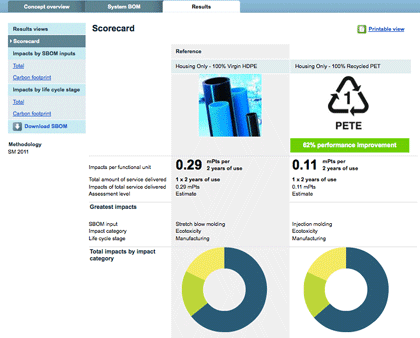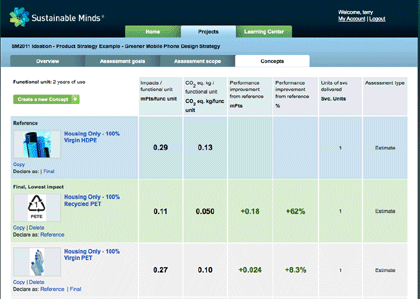

This is a repost of Al Dean's review of Sustainable Minds 2.0.
Read the review on DEVELOP3D > [2]
. . .
Life Cycle Assessment (LCA) is increasingly pushing towards the cloud and Software as a Service (SaaS). Al Dean takes a look at one of the industry’s pioneers.

Life Cycle Assessment is a corner-stone of any environmentally aware organisation’s toolkit, but there’s one serious issue if you’re looking to both integrate environmental impact assessment as part of your design process - particularly at the early stages.
Many of the historical solutions are mono- lithic systems targetting in-depth, expert led analyses once a product is complete. As such, they aren’t suited to the rapid fire, often quick and dirty conceptualisation and product development process.
Into this comes Sustainable Minds (SM) and its cloud-based service.
Essentially, it gives you tools to upload a BOM (which can quickly be extracted from your assembly) or create one from scratch, then add in the manufacturing (materials and processes), transportation, use phase and end of life data and find out the environmental impact of that product.
While that’s pretty much standard fair for LCA tools, what SM has done is combine eco-concept modelling capablities with LCA.
This allows product teams to generate many concepts and credibly estimate, eval- uate, compare and track the life cycle environmental and human health performance.
The ability to rapidly model and compare is powerful to determine which changes will yield meaningful environmental per- formance improvements to make informed trade-offs. You can tweak either the prod- uct itself or play with other factors, such as manufacturing location, process, materi- als and such. This makes it ideal for new product development in R&D, early stage prototyping or if you’re conducting a design refresh on a product.
Data sourcing
The biggest change in the Sustainable Minds 2.0 release is an update in the meth- od used to calculate the impact factors.
SM 2011 uses the latest science from the U.S. Environmental Protection Agency, and the latest life cycle inventory data.
Within the LCA world, data and how you interpret it is key. Sustainable Minds is using the most up-to-date version of the Ecoinvent data (which is perhaps the world’s most widely used environmental impact dataset) enhanced with some addi- tional background information from other leading sources.
This release also brings in an expanded dataset of impact factors. The system already includes impacts such as materials, processes, use stage consum- ables, transportation, end of life - the 2.0 release added in more processes for metal work, more bio-based materials (such as bamboo and bagasse) and extension of the ‘end of life’ impact factors.
Having been following what Sustainable Minds has been doing for a while, I like the direction it is taking with the latest release. There’s expansion of the impacts that allows you to closer match the values you feed into the system to real-life conditions (metal working is something in particular that’s been worked on).
Also, the ability to quickly replicate a project, fine tune it and see the impacts, allows you to take existing or pre-worked data and use it as the basis for experimentation - and in these days of more and more pressure on the environmental factors involved in our products manufacture and use-phase, that’s going to be key, particularly if you’re serious about this and want to bring it in as part of your development process.
 With Sustainable Minds, product teams can quickly build and compare multiple concepts and investigate their impacts - clearly and concisely Each concept is compared to a baseline. Results are perfect for including in presentations and documents to support decisions
With Sustainable Minds, product teams can quickly build and compare multiple concepts and investigate their impacts - clearly and concisely Each concept is compared to a baseline. Results are perfect for including in presentations and documents to support decisions
The perfect cloud solution?
The cloud or SaaS (Software as a Service) nature of the offering makes huge sense. Database updates can be quickly rolled out and updated once you request them and the data is sourced and verified. I had an experience of this myself, working through a test project.
There wasn’t specific information pertaining to the impact of machining aluminium from a billet. I contacted support and the impact factors were added within three working days. That’s both an indicator of the benfeits of the cloud (as everyone also had that data rolled out to them) and of the service that Sustainable Minds is offering.
The team is also offering an enterprise level version if you want your own data hosted, want to include custom and proprietary impact factors and want to allow access to a much wider range of your team. That comes at an additional cost as you would expect.
Conclusion
If you’re looking at LCA becoming part of your design process, I couldn’t recommend Sustainable Minds offering more.
Its light in terms of user experience, has a tonne of learning resources to help you both use the system and understand the concepts while being heavyweight in terms of data and potential benefit.
It’s available now, up-to-date and frankly, it’s pretty damned cost- effective at $120/month, or $1200/year for one user. Because products get designed by teams, it’s $3,500 for five users.
It doesn’t get much better than this.
Links:
[1] http://www.sustainableminds.com/files/images/blog/20110802_sm_1_0.gif
[2] http://www.develop3d.com/sustainability/sustainable-minds-lca-2.0